Abstract
Roof failure related to laminated and jointed rock masses has been recognized as a major cause of fatalities in underground coal mines. This paper presents numerical simulations of the failure of a laminated and jointed roof using the discrete element method, while focusing on the initiation and propagation of (and the interactions between) microcracks and macroscopic fractures and the development of the associated damage, stress and deformation in the laminated and jointed roof. Numerical modeling shows that the behaviors of bedding planes and vertical joints governed the progressive failure of the laminated and jointed roof. Microseismic activity corresponding to the development of microcracks in the roof intensified before major roof displacements and subsided in the later stages; such activity could serve as a precursor of roof fall events. The effectiveness of various support elements (rock bolts, metal meshes, and anchor cables) on the roof stability was numerically evaluated. Rock bolts and/or anchor cables produced a banded compressive stress in the laminated roof, restricting the separation of bedding planes. Rock bridges in the bolted roof suppressed the formation of macroscopic fractures and significantly reduced the interactions between fractures. The roof skin support with a metal mesh provided confinement to the fractured roof, thereby preventing fragmented rocks from falling and restricting progressive spalling between bolts. The numerical simulations presented in this paper can be helpful for understanding the likely failure mechanisms of laminated and jointed roofs and for finding potential solutions.

















Similar content being viewed by others
References
Adhikary DP, Dyskin AV (1997) Modelling the deformation of underground excavations in layered rock masses. Int J Rock Mech Min Sci 34(3–4):5.e1–5.e12
Agapito J, Gilbride L (2002) Horizontal stresses as indicators of roof stability. In: 2002 SME annual meeting, Phoenix, Arizona, USA, Preprint 02-056
Alejano LR, Taboada J, García-Bastante F, Rodriguez P (2008) Multi-approach back-analysis of a roof bed collapse in a mining room excavated in stratified rock. Int J Rock Mech Min Sci 45(6):899–913
Bai Q, Tu S (2016) Failure analysis of a large span longwall drift under water-rich roofs and its control techniques. Eng Fail Anal 67:15–32
Bai Q, Tu S (2019) A general review on longwall mining-induced fractures in near-face regions. Geofluids 2019:3089292
Bai Q-S, Tu S-H, Zhang C, Zhu D (2016a) Discrete element modeling of progressive failure in a wide coal roadway from water-rich roofs. Int J Coal Geol 167:215–229
Bai Q, Tu S, Zhang C (2016b) DEM investigation of the fracture mechanism of rock disc containing hole(s) and its influence on tensile strength. Theor Appl Fract Mech 86:197–216
Bai Q, Tu S, Wang F, Zhang C (2017) Field and numerical investigations of gateroad system failure induced by hard roofs in a longwall top coal caving face. Int J Coal Geol 173:176–199
Bakun-Mazor D, Hatzor YH, Dershowitz WS (2009) Modeling mechanical layering effects on stability of underground openings in jointed sedimentary rocks. Int J Rock Mech Min Sci 46(2):262–271
Bruno MS, Nakagawa FM (1991) Pore pressure influence on tensile fracture propagation in sedimentary rock. Int J Rock Mech Min Sci Geomech Abstr 28(4):261–273
Cai M (2008) Influence of stress path on tunnel excavation response—numerical tool selection and modeling strategy. Tunn Undergr Space Technol 23(6):618–628
Cai M, Lai X (2003) Study and application of monitoring for subsiding area in a composite hard rock roadway. Chin J Rock Mechan Eng 22(3):391–394
Coggan J, Gao F, Stead D, Elmo D (2012) Numerical modelling of the effects of weak immediate roof lithology on coal mine roadway stability. Int J Coal Geol 90–91:100–109
Diederichs MS, Kaiser PK (1999) Stability of large excavations in laminated hard rock masses: the voussoir analogue revisited. Int J Rock Mech Min Sci 36(1):97–117
Esterhuizen GS, Tulu IB (2016) Analysis of alternatives for using cable bolts as primary support at two low-seam coal mines. Int J Min Sci Technol 26(1):23–30
Fabjan T, Ivars DM, Vukadin V (2015) Numerical simulation of intact rock behaviour via the continuum and voronoi tessellation models: a sensitivity analysis. Acta Geotechnica Slovenica 12(2):4–23
Firth R, Reed G, McKinnon M (2017) Fundamental principles of an effective reinforcing roof bolting strategy in horizontally layered roof strata and three areas of potential improvement. In: Proceedings of the 17th coal operators’ conference, Wollongong, New South Wales, pp 149–170
Frith R, Reed G, McKinnon M (2018) Fundamental principles of an effective reinforcing roof bolting strategy in horizontally layered roof strata and areas of potential improvement. Int J Min Sci Technol 28(1):67–77
Galvin J (2016) Ground engineering-principles and practices for underground coal mining. Springer, Berlin
Gao F, Stead D (2013) Discrete element modelling of cutter roof failure in coal mine roadways. Int J Coal Geol 116–117:158–171
Gao FQ, Stead D (2014) The application of a modified Voronoi logic to brittle fracture modelling at the laboratory and field scale. Int J Rock Mech Min Sci 68:1–14
Gao F, Stead D, Kang H (2014) Simulation of roof shear failure in coal mine roadways using an innovative UDEC Trigon approach. Comput Geotech 61:33–41
Ghazvinian E, Diederichs MS, Quey R (2014) 3D random Voronoi grain-based models for simulation of brittle rock damage and fabric-guided micro-fracturing. J Rock Mech Geotech Eng 6(6):506–521
Hatzor YH, Benary R (1998) The stability of a laminated Voussoir beam: back analysis of a historic roof collapse using DDA. Int J Rock Mech Min Sci 35(2):165–181
Hazzard JF, Young RP (2004) Dynamic modelling of induced seismicity. Int J Rock Mech Min Sci 41(8):1365–1376
Hebblewhite BK, Lu T (2004) Geomechanical behaviour of laminated, weak coal mine roof strata and the implications for a ground reinforcement strategy. Int J Rock Mech Min Sci 41(1):147–157
Iannacchione AT, Coyle PR, Prosser LJ, Marshall TE, Litsenberger J (2004) The relationship of roof movement and strata-induced microseismic emissions to roof falls. In: 2004 SME annual meeting, Denver, Colorado, USA, Preprint 04-58
Itasca Consulting Group Inc. (2016) UDEC (Universal Distinct Element Code). Version 6, Minneapolis
Jiang Y, Li B, Yamashita Y (2009) Simulation of cracking near a large underground cavern in a discontinuous rock mass using the expanded distinct element method. Int J Rock Mech Min Sci 46(1):97–106
Kazerani T, Zhao J (2010) Micromechanical parameters in bonded particle method for modelling of brittle material failure. Int J Rock Mech Min Sci 34(18):1877–1895
Kong P, Jiang L, Shu J, Sainoki A, Wang Q (2019) Effect of fracture heterogeneity on rock mass stability in a highly heterogeneous underground roadway. Rock Mech Rock Eng 52(11):4547–4564
Lin J, Sun Z (2013) Laboratory studies on mechanical performance and supporting function of bolt metal meshes. J China Coal Soc 39(9):1542–1548
Lisjak A, Grasselli G (2014) A review of discrete modeling techniques for fracturing processes in discontinuous rock masses. J Rock Mech Geotech Eng 6(4):301–314
Lisjak A, Grasselli G, Vietor T (2014a) Continuum–discontinuum analysis of failure mechanisms around unsupported circular excavations in anisotropic clay shales. Int J Rock Mech Min Sci 65:96–115
Lisjak A, Liu Q, Zhao Q, Mahabadi OK, Grasselli G (2014b) Numerical simulation of acoustic emission in brittle rocks by two-dimensional finite-discrete element analysis. Geophys J Int 196(2):1263–1263
Molinda G, Mark C (2010) Ground failures in coal mines with weak roof. Electr J Geotech Eng 15(F):547–588
Murphy MM (2016) Shale failure mechanics and intervention measures in underground coal mines: results from 50 years of ground control safety research. Rock Mech Rock Eng 49(2):661–671
Pappas DM, Mark C (2011) Roof and rib fall incident trends: a 10-year profile. Trans Soc Min Metall Explor 330(1):462–478
Peng SS (2007) Ground control failures: a pictorial view of case studies. West Virginia University, Morgantown
Peng SS (2013) Coal mine ground control, 3rd edn. China University of Mining and Technology Press, Xunzhou
Peng SS (2015) Topical areas of research needs in ground control—a state of the art review on coal mine ground control. Int J Min Sci Technol 25(1):1–6
Ran JQ, Passaris EKS, Mottahed P (1994) Shear sliding failure of the jointed roof in laminated rock mass. Rock Mech Rock Eng 27(4):235–251
Ray AK (2009) Influence of cutting sequence and time effects on cutters and roof falls in underground coal mine—numerical approach. Dissertation, West Virginia University
Seedsman RW (2013) Practical strength criterion for coal mine roof support design in laminated soft rocks. Min Technol 122(4):243–249
Seedsman R (2018) The spalling limit in transversely isotropic materials, the prediction of the maximum height of failure, and the design of long-tendon roof support systems. Min Technol 127(2):65–74. https://doi.org/10.1080/14749009.2017.1325552
Shabanimashcool M, Li CC (2015) Analytical approaches for studying the stability of laminated roof strata. Int J Rock Mech Min Sci 79:99–108
Shen B (2014) Coal mine roadway stability in soft rock: a case study. Rock Mech Rock Eng 47(6):2225–2238
Shen B, King A, Guo H (2008) Displacement, stress and seismicity in roadway roofs during mining-induced failure. Int J Rock Mech Min Sci 45(5):672–688
Sherizadeh T, Kulatilake PHSW (2016) Assessment of roof stability in a room and pillar coal mine in the US using three-dimensional distinct element method. Tunn Undergr Space Technol 59:24–37
Sofianos AI, Kapenis AP (1998) Numerical evaluation of the response in bending of an underground hard rock voussoir beam roof. Int J Rock Mech Min Sci 35(8):1071–1086
Stone R (2016) Design of primary ground support during roadway development using empirical databases. Int J Min Sci Technol 26(1):131–137
Su E, Liang Y, Zou Q, Niu F, Li L (2019) Analysis of effects of CO2 injection on coalbed permeability: implications for coal seam CO2 sequestration. Energy Fuels 33(7):6606–6615
Tang C-A, Yang T-H, Li L-C, Liang Z-z, Tham LG, Lee KK, Tsui T (2003) Numerical simulation to influence of pore pressure magnitude and gradient on fracture propagation in brittle heterogeneous rocks. Rock Soid Mech 24(S2):17–20
Tulu IB, Esterhuizen GS, Klemetti T, Murphy MM, Sumner J, Sloan M (2016) A case study of multi-seam coal mine entry stability analysis with strength reduction method. Int J Min Sci Technol 26(2):193–198
Xu Q, Zhao Y, Li Y (2015) Statistical analysis and precaution of coal mine accidents in China. Coal Eng 47(3):80–82
Young M, Walton G, Holley E (2019) Investigation of factors influencing roof stability at a Western US longwall coal mine. Int J Min Sci Technol 29(1):139–143
Yuan Y, Liu ZH, Zhu C, Yuan CF, Wang SZ (2019) The effect of burnt rock on inclined shaft in shallow coal seam and its control technology. Energy Sci Eng 7(5):1882–1895
Zhang L, Einstein HH (2004) Using RQD to estimate the deformation modulus of rock masses. Int J Rock Mech Min Sci 41(2):337–341
Zhang K, Zhang G, Hou R, Wu Y, Zhou H (2015) Stress evolution in roadway rock bolts during mining in a fully mechanized longwall face, and an evaluation of rock bolt support design. Rock Mech Rock Eng 48(1):333–344
Acknowledgements
This work was supported by the National Key R&D Program of China (2018YFC0604701) and National Natural Science Foundation of China (Nos. 51704278, 51874218). The authors are grateful to the anonymous reviewers for their useful comments and constructive suggestions.
Author information
Authors and Affiliations
Corresponding authors
Additional information
Publisher's Note
Springer Nature remains neutral with regard to jurisdictional claims in published maps and institutional affiliations.
Rights and permissions
About this article
Cite this article
Bai, Q., Tu, S. Numerical observations of the failure of a laminated and jointed roof and the effective of different support schemes: a case study. Environ Earth Sci 79, 202 (2020). https://doi.org/10.1007/s12665-020-08935-2
Received:
Accepted:
Published:
DOI: https://doi.org/10.1007/s12665-020-08935-2




